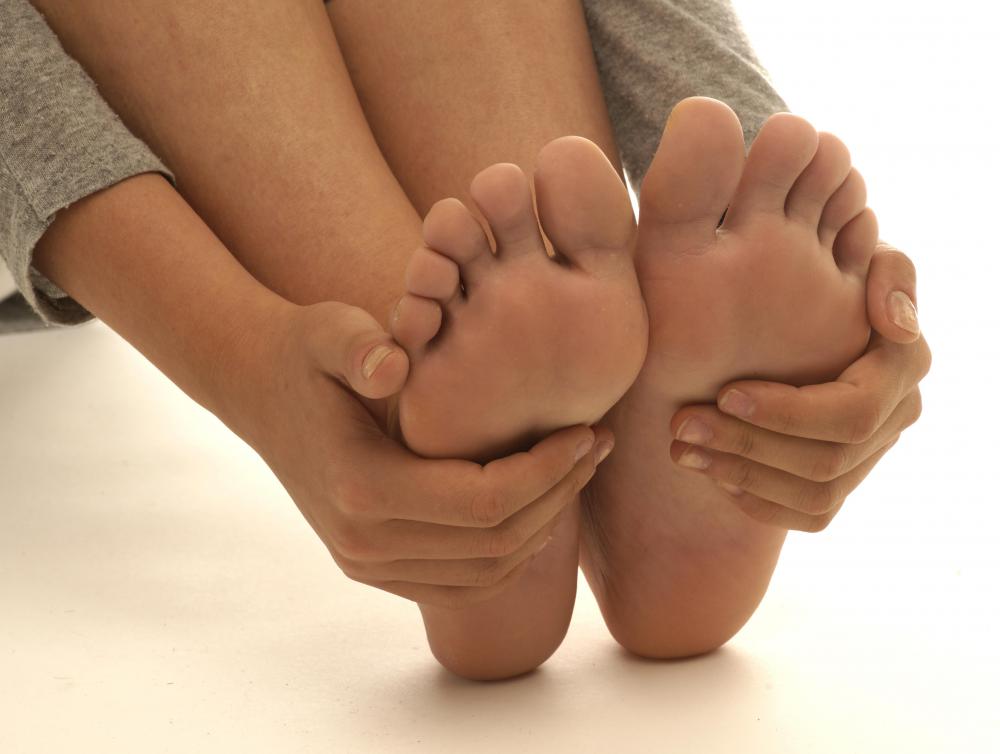At WiseGEEK, we're committed to delivering accurate, trustworthy information. Our expert-authored content is rigorously fact-checked and sourced from credible authorities. Discover how we uphold the highest standards in providing you with reliable knowledge.
What are the Different Types of Night Splints?
Though night splints come in various designs, they help get rid of a foot problem by holding the foot and ankle in a specific position while the wearer sleeps. The foot problems that may be treated with a night splint can vary from plantar fasciitis to to drop foot to heel spurs, among others. Depending upon the problem the night splint aims to fix, the splint itself might be made from a soft or rigid material; it might be an adjustable splint or it might be fixed; and it may cover different parts of the foot, ankle, or leg area.
Night splints are typically a combination of a soft material, such as foam, and a rigid outer material such as plastic. The rigid part of the splint provides the immobilization, while the foam padding provides comfort. In an effort to make night splints more comfortable, some splints have padding outside the rigid external component as well. No matter what the style, manufacturers also strive to make the padding from breathable materials. Another feature in some splints is inclusion of a cold pack to provide extra pain relief. Some night splints can be folded for travel and are machine washable.

A dorsal foot splint gently pulls the toes upward to stretch the Achilles tendon and the plantar fascia ligament. The stretching serves to alleviate pain and speed recovery, and the dorsal foot splint is used to treat plantar fasciitis, Achilles tendinitis, and other heel problems. The splint sits on the shin so that the back of the ankle and the heel are typically uncovered. A dorsal foot splint is generally considered more comfortable than other night splints, which may lead to longer periods of wear at night and theoretically speed recovery.

A dorsal foot splint does not typically allow the splint to be adjusted for different angles of stretching. An adjustable boot style night splint, on the other hand, permits the wearer to adjust the amount of stretch used on the Achilles tendon. A patient might first wear the boot splint set at the lowest possible angle and then gradually increase the angle. This may help with pain management and may speed recovery.

A foam foot elevator is a device that helps prevent foot ulcers and foot drop. A polyurethane foam device is placed just above the ankle to elevate the foot above the bed several inches. A wide strap across the instep holds the foot gently in place in an upright position.
AS FEATURED ON:
AS FEATURED ON:














Discussion Comments
Just be careful that you don't try to fit night splints yourself, or even self diagnose what is wrong in the first place. It might not seem like a big deal to strap yourself into a splint every night, but if you pull one muscle out of alignment with another, you could end up in pain without knowing why.
If you don't want to go to a doctor, at least go to a physiotherapist and get their opinion.
@MrsPramm - There are plenty of women who wear high heels all the time and don't need night splints, or other kinds of plantar fasciitis treatment.
The truth is that humans put their feet to all kinds of use and abuse that they weren't really designed for and sometimes that will mean they get hurt. Ideally, we'd all be walking barefoot over soft grass all the time, but that's not going to happen.
And a night splint isn't all that bad really. I've had to use one for a sprained ankle and it hardly bothered me.
Often what causes the Achilles tendon to be short or tight in the first place, or causes plantar fasciitis until a night splint is necessary, is the overuse of high heels.
Women take them for granted, but they can be extremely damaging to your feet, particularly if you use them all the time. I know a couple of women who were told to wear a splint at night so they wouldn't end up ripping their tendons after they got too short. And they still insist on wearing heels everywhere.
I don't think people should never wear them, but they need to be seen as an ornament for special occasions, rather than an everyday shoe.
Post your comments